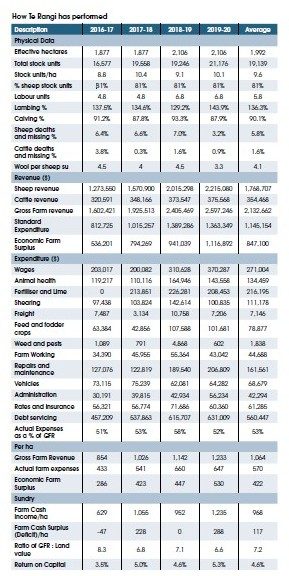Tony Leggett
Holding a winter stocking rate 12% higher than the average for similar properties is helping deliver above average economic farm surpluses for this year’s Kienzley Agvet Wairarapa Farm Business of the Year.
Winners Stuart and Jane McKenzie operate Te Rangi Station, 2106 hectares (effective) of medium hill, semi-finishing, summer-dry country in the Whangaehu Valley north of Masterton. It is a class 2 property under BakerAg’s Financial Analysis Benchmarking (FAB) system but has operated at a winter stocking rate of 9.6 stock units/ha on average over the past four years.
BakerAg farm consultant Chris Garland said Te Rangi’s financial performance is impressive because it has doubled its annual EFS over the past four years, from $536,000 to $1.1 million. Importantly, EFS has also increased on a per-ha basis.
“That’s impressive because it’s happened during an expansion phase and because it is also occurring over a scale that is almost twice the average for the district,” Garland said.
“That reflects a competent level of logistics and man management along with close attention to detail.”
Te Rangi’s average revenue is $1064/ha, compared to $962/ha for class average. Garland said this 10% difference is driven largely by the 12% higher stocking rate.
Actual operating expenditure over the past four years has averaged $570/ha or 53% of gross revenue on an adjusted basis (fertiliser and repairs and maintenance costs standardised). This compares to the class average of 56%.
Reflecting the high level of gearing in the debt structure needed to grow the land area in recent years, interest and rent costs are 44% higher/su than the average at around $29/su.
“At 24% of gross revenue in the 2019/20 year, this level of debt servicing is still manageable, but it is dependent on interest rates staying low and revenue levels being maintained,” Garland said.
Te Rangi’s EFS/ha averaged $385 for the three years from 2017 to 2019, compared with the class average of $317/ha over the same period. Garland said this difference arises from the 10% higher revenue per hectare and the economies of scale that apply over the additional fixed costs of wages of management and depreciation that go into the EFS calculation, which are spread over a larger number of hectares on Te Rangi.
Based on a land and buildings value of $8100/ha ($17m), $118,000 worth of plant and machinery and stock value of $4.1m, the return on total capital represented by the $1.1m EBIT is 5.3%. The corresponding figure for the previous financial year is 4.6%.
“This result is approximately 8 percentage points higher than the average for this class,” he said.
Garland noted Te Rangi’s high sheep to cattle ratio, at 81:19 versus the class 2 average of 70:30 and some potential to increase sheep reproductive performance.
Average lambing percentage over the past four years is 136.3% – slightly under the Class 2 average – but Garland said the sheep genetics on Te Rangi are capable of better performance.
“Given the high sheep ratio, the potential to improve lamb percentage is a significant opportunity. If Te Rangi’s lambing percentage lifted by 10%, this would generate a further $126,000, adding another $60/ha to gross farm revenue.”
Beef financial performance at $98/cattle stock unit is close to the Class 2 average of $102/csu. But calving percentage has averaged just over 90% for the past four years – 4% higher than the average – and death/missing rate in cattle is slightly lower than average at 1.6%.
Farm expenditure is likely to be fleshed out during the field day discussion planned for Te Rangi later this year, Garland said.
“For instance, Te Rangi’s per stock unit expenditure on wages and animal health tend to be 16% and 33% higher than the average respectively. This may reflect the higher sheep ratio which is more labour-intensive and demanding on animal health inputs.”
Another topic for the field day will be average annual spend on fertiliser which is $215,000 or around $11.25/su (on phosphate and sulphur component). This compares with the average spend of $10.22/su for Class 2 properties.
“Maintenance fertiliser expenditure for a property of Te Rangi size might be expected to be $262,000 or at least $12 a stock unit. Again, that will be a good topic for the further discussion and explanation at the field day.”




